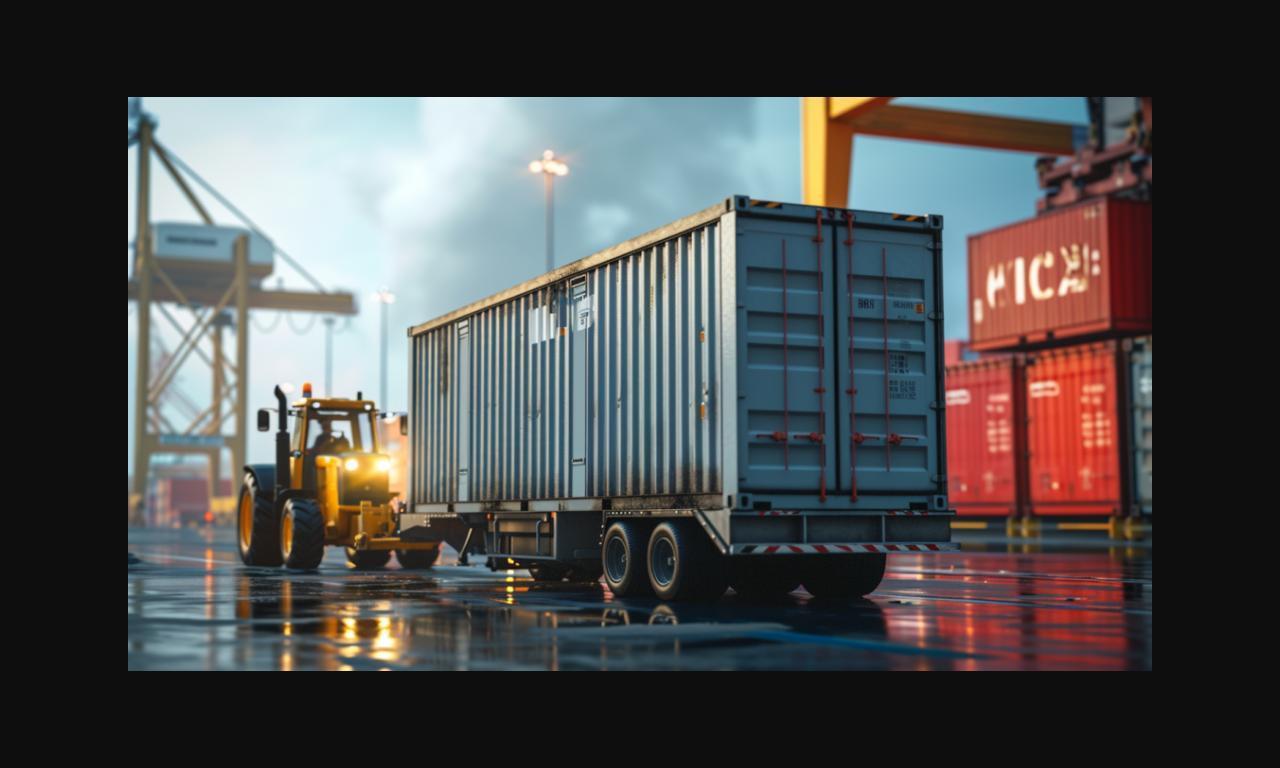Efficient Methods for Shipping Container Transport
In the fast-paced world of global commerce, the efficient transport of shipping containers is essential for businesses to thrive. These sturdy metal boxes, packed with goods of all kinds, traverse oceans and continents, connecting manufacturers, suppliers and consumers worldwide.
Yet, behind this seemingly straightforward process lies a complex web of logistics, technologies and strategies aimed at optimizing efficiency and minimizing costs. In this blog post, we’ll delve into the world of efficient methods for shipping container transport, exploring innovative solutions and best practices that drive success in today’s competitive market.
The Importance of Efficiency in Container Transport
Efficiency in shipping container transport is not merely about moving cargo from point A to point B—it’s about doing so in the most cost-effective, timely and sustainable manner possible. In an industry where margins are often tight and competition fierce, even small improvements in efficiency can translate into significant savings and competitive advantages. Efficient container transport methods contribute to:
Cost Savings: Streamlining transport operations reduces expenses associated with fuel, labor, maintenance and other overhead costs, ultimately improving the bottom line for businesses involved in global trade.
Time Optimization: Imagine a world where your goods zip across distances, reaching customers not just on time, but maybe even before they expect it. This isn’t just about making customers happy (though it does a great job of that), it’s about setting your business apart in a bustling marketplace. It’s about being nimble, responsive, and ahead of the curve. That’s the magic of cutting down on transit times.
Environmental Sustainability: Now, let’s talk about our planet. It’s no secret that our choices today shape the world of tomorrow. By choosing more efficient ways to transport containers, we’re doing more than just business. We’re making a pledge to minimize our environmental impact — less fuel, less emissions, and a smaller carbon footprint. And here’s where it gets interesting: used conex containers. These aren’t just any containers. They’re a testament to what happens when we decide to repurpose with purpose. Secure, durable, and available in sizes to fit all sorts of needs, they’re a brilliant example of how making environmentally savvy choices doesn’t mean sacrificing quality or efficiency.
In weaving these considerations into the fabric of our operations, we demonstrate a commitment not just to our customers, but to our planet. Choosing used conex containers isn’t just a smart business decision; it’s a step towards a more sustainable, conscientious way of operating in our world.

Innovations in Container Transport Efficiency
In recent years, the container transport industry has witnessed significant innovations aimed at enhancing efficiency across various stages of the logistics chain:
- Intermodal Transport Integration: Integrating multiple modes of transport, such as ships, trucks and trains, into seamless intermodal networks enables efficient door-to-door delivery solutions. By optimizing route planning, scheduling and modal shifts, businesses can minimize transit times and maximize resource utilization.
- Smart Container Technologies: The advent of smart container technologies, equipped with sensors, GPS tracking, and telematics systems, provides real-time visibility into container location, status and condition. This data enables proactive decision-making, reduces the risk of theft, damage and loss and enhances supply chain transparency and resilience.
- Port Automation: Automation technologies, including robotic cranes, automated guided vehicles (AGVs) and terminal operating systems (TOS), streamline port operations, reducing turnaround times and increasing throughput capacity. Automated container handling processes minimize human error, optimize container stacking and improve overall terminal efficiency.
- Predictive Analytics: Leveraging big data analytics, machine learning algorithms and predictive modeling techniques enables stakeholders to anticipate demand fluctuations, optimize inventory management and mitigate risks of disruptions. Predictive analytics also facilitate predictive maintenance of transport assets, reducing downtime and enhancing operational reliability.
Considerations on Choosing a Provider
When selecting a provider for shipping container transport services, there are several important factors to consider:
Reliability and Track Record: Look for a provider with a proven track record of reliable and on-time deliveries. Review their service history and customer testimonials to assess their performance.
Comprehensive Service Offerings: Opt for a provider that can offer a full suite of services, including container leasing, intermodal transportation, and value-added logistics solutions. This ensures a seamless and integrated supply chain experience.
Geographical Coverage: Evaluate the provider’s network and reach, ensuring they can efficiently serve your domestic and international shipping needs across multiple regions and modes of transport.
Technological Capabilities: Consider providers that leverage advanced technologies, such as smart containers, predictive analytics, and real-time visibility, to enhance efficiency and responsiveness.
Sustainability Practices: Prioritize providers that demonstrate a commitment to environmental sustainability, such as using fuel-efficient equipment, implementing eco-friendly practices, and offering carbon-neutral shipping options.
Flexibility and Scalability: Choose a provider that can adapt to your changing business needs, whether it’s handling fluctuations in volume or accommodating special requirements.
By carefully evaluating these considerations, businesses can identify the right shipping container transport provider to meet their needs, optimize their supply chain, and gain a competitive edge in the global marketplace.
Best Practices for Container Transport Efficiency
In addition to technological innovations, implementing best practices and operational strategies is crucial for achieving efficiency in shipping container transport:
- Optimized Container Packing: Maximizing container utilization through efficient packing practices, such as cubing, palletization and load optimization, minimizes wasted space and reduces the number of containers required for a given volume of cargo.
- Route Optimization: Utilizing route optimization software and algorithms helps minimize transit distances, reduce fuel consumption, and optimize delivery schedules. By identifying the most efficient transport routes and modes, businesses can achieve significant cost and time savings.
- Collaborative Partnerships: Building collaborative partnerships with shipping lines, logistics providers and other stakeholders fosters synergies, economies of scale, and shared resources. Collaborative efforts enable the pooling of cargo volumes, consolidation of shipments and optimization of transport networks, leading to cost efficiencies and service enhancements.
- Continuous Improvement: Embracing a culture of continuous improvement and innovation is essential for staying ahead in the dynamic container transport industry. By soliciting feedback, analyzing performance metrics and exploring new technologies and methodologies, businesses can identify areas for optimization and drive ongoing efficiency gains.
How can businesses collaborate to improve efficiency in container transport?
Collaborative partnerships with shipping lines, logistics providers, and other stakeholders foster synergies, economies of scale and shared resources. They enable the pooling of cargo volumes, consolidation of shipments and optimization of transport networks.
What are the benefits of efficiency in shipping container transport?
Efficiency leads to cost savings, faster transit times, improved customer satisfaction, and reduced environmental impact. It enhances competitiveness, agility and resilience in the global marketplace.
Where can I find used conex containers for efficient storage solutions?
Businesses and individuals have several options for obtaining used conex containers. Various suppliers offer used conex containers for sale, which can provide cost-effective storage solutions. When exploring this option, it’s important to carefully evaluate the condition and suitability of the used containers to ensure they meet your specific requirements.
Conducting an online search or contacting local container suppliers can help you find available options and compare pricing and quality. Additionally, consider factors such as container size, modifications, and delivery logistics when selecting used conex containers for your storage and shipping needs.
Why is continuous improvement important for container transport efficiency?
Embracing a culture of continuous improvement and innovation allows businesses to identify areas for optimization and drive ongoing efficiency gains. Analyzing performance metrics and exploring new technologies help stay ahead in the dynamic container transport industry.
How do automation technologies contribute to efficient container transport?
Automation technologies, such as robotic cranes and terminal operating systems, streamline port operations, reduce turnaround times, and minimize human error. They optimize container handling processes and enhance terminal efficiency.
What role do smart container solutions play in enhancing efficiency?
Smart container technologies, equipped with sensors and GPS tracking, provide real-time visibility into container location, status and condition. This data enables proactive decision-making, reduces risks, and enhances supply chain transparency.
What is intermodal transport, and how does it improve efficiency?
Intermodal transport integrates multiple modes of transportation, such as ships, trucks and trains, into seamless networks. It enables efficient door-to-door delivery solutions and maximizes resource utilization.
Conclusion: Efficient methods for shipping container transport are fundamental to the success of businesses engaged in global trade. By embracing technological innovations, implementing best practices, and fostering collaborative partnerships, companies can optimize their transport operations, reduce costs and enhance customer satisfaction. In a world where speed, reliability and sustainability are paramount, efficiency is not just a goal but a strategic imperative for thriving in the competitive landscape of containerized commerce. As the industry continues to evolve, businesses that prioritize efficiency will remain well-positioned to navigate the challenges and seize the opportunities of the global marketplace.
Contents
- 1
- 1.1 Efficient Methods for Shipping Container Transport
- 1.2 The Importance of Efficiency in Container Transport
- 1.3 Innovations in Container Transport Efficiency
- 1.4 Considerations on Choosing a Provider
- 1.5 Best Practices for Container Transport Efficiency
- 1.5.1 How can businesses collaborate to improve efficiency in container transport?
- 1.5.2 What are the benefits of efficiency in shipping container transport?
- 1.5.3 Where can I find used conex containers for efficient storage solutions?
- 1.5.4 Why is continuous improvement important for container transport efficiency?
- 1.5.5 How do automation technologies contribute to efficient container transport?
- 1.5.6 What role do smart container solutions play in enhancing efficiency?
- 1.5.7 What is intermodal transport, and how does it improve efficiency?



